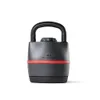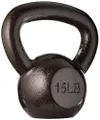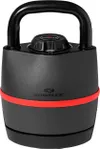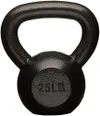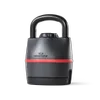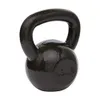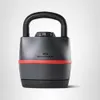
This kettlebell complex uses four exercises to strengthen your body, and you only need a single bell to do it. Sign me up. Best of all, the kettlebell workout takes eight minutes to blast your core and improve your overall functional fitness.
We turned to the Kings themselves (Kettlebell Kings, that is) for inspiration, and it’s almost laughable how efficient yet effective this complex is. If you’re unfamiliar with a complex, it simply means stringing a series of exercises together into a sequence — like a yoga flow routine without the downward dogs.
Pick up one of the best kettlebells for weightlifting, take a deep breath and put your trust (and spare eight minutes) into this short full-body kettlebell routine
What is the 4-move kettlebell complex?
Despite not classing itself as a typical ab workout, the four moves will test your core and shoulder stability while strengthening your shoulders, arms, back, glutes, hips, and legs.
To do the workout, grab a medium to heavy kettlebell. What weight you choose depends on your kettlebell experience, but you’ll find it easier to maneuver your bell if you learn how to hold a kettlebell properly; it’ll help you develop the correct movement patterns early on and prevent injury down the line.
The generous cluster of kettlebell exercises will help you quickly identify weak points — particularly for your core and shoulder strength and stability. If you’re new to complexes, start with the first exercise, practice for several reps, add the next and so on. Slowly build them into a sequence, ensuring you can transition smoothly from one to the next.
Kettlebell swing
First, introduce the kettlebell swing. Use your hips and glutes to help thrust the bell forward to shoulder height, then control the weight back between your legs before moving to the clean. Swings heavily recruit your posterior chain muscles, including the lower back, glutes, hamstrings, core, and hip flexors.
Get instant access to breaking news, the hottest reviews, great deals and helpful tips.
Kettlebell clean
Next, you’ll use the swing's power to clean the kettlebell to your shoulder, racking it into place with a strong core and neutral spine. Before you move to the bent press, practice compound contraction (squeeze as many muscles as you can) and imagine your body as a pillar of strength that will support the next movement.
Kettlebell bent press
Once secure, gently twist in the same direction as the arm holding the bell and engage your obliques (the core muscles that run down your waist between your ribs and pelvis) and back.
As you squat, punch the kettlebell overhead and look at the weight; keep the weight pressed overhead aligned with your shoulder as you stand up. You’ll exercise full muscular control without rushing through either phase of the move. Looking up should help keep the arm raised but will also test your balance.
Kettlebell windmill
The kettlebell windmill is a well-known core exercise that recruits your abs, obliques, hip flexors, glutes, hamstrings, shoulders, and various stabilizing muscles like the rotator cuffs, upper back, and rhomboids.
Slightly turn your feet to the sides, hinge forward at the hips, and softy bend one knee as you extend the opposite arm overhead; the move tests shoulder ability and stability and hamstring flexibility to keep the bell in place as you lower then stand again. Re-rack your kettlebell, then switch sides and head straight into the swings without resting.
Complete one rep of each move per side, then rest for the remainder of the minute for a total of 5-8 rounds; this workout format is known as an EMOM — every minute on the minute.
Maximize your working sets by keeping close to failure using a heavy kettlebell, and if you finish with too much time to spare, consider adding load so that you need the rest before the next round.
Remember to pick a weight suitable for your weakest side and avoid swapping weight ranges between left and right. Working this out early will help you level up any potential muscular imbalances, which will be crucial if you like to work with barbells as it's common to pick up imbalances on the bar.
More from Tom's Guide
- Forget crunches — build a stronger core with this 10-minute standing abs workout
- Forget sit-ups — 3 seated ab exercises that build your core muscles using one dumbbell
- Forget ab exercises — this full-body kettlebell workout strengthens your core in 4 moves and 8 minutes

Sam Hopes is a level 3 qualified trainer, a level 2 Reiki practitioner and fitness editor at Tom's Guide. She is also currently undertaking her Yoga For Athletes training course.
Sam has written for various fitness brands and websites over the years and has experience across brands at Future, such as Live Science, Fit&Well, Coach, and T3.
Having coached at fitness studios like F45 and Virgin Active and personal trained, Sam now primarily teaches outdoor bootcamps, bodyweight, calisthenics and kettlebells.
She also coaches mobility and flexibility classes several times a week and believes that true strength comes from a holistic approach to training your body.
Sam has completed two mixed doubles Hyrox competitions in London and the Netherlands and finished her first doubles attempt in 1:11.

